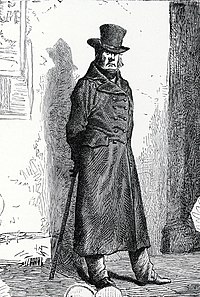art.wikisort.org - Artist
Gustave Brion (1824–1877) was a French painter and illustrator. He was born at Rothau in the department of Bas-Rhin on 24 October 1824. In 1841, in Strasbourg, he entered the studio of Gabriel Guérin, with whom he remained three years; he also received tuition from Andreas Friedrich, the sculptor; but he soon afterwards went to Paris, where his first work appeared at the Salon in 1847; it was entitled Interior of a Farm at Dambach. Six years later he gained a medal of the second class for his 'Schlitteurs de la Foret-Noire' and the Potato Harvest during an Inundation, the former of which was subsequently burned at Strassburg by the Prussians. His fame was further established by his Le Train de Bois sur le Rhin in 1855, and from that time his works continued to increase in public favour, and gained considerable praise and recompense for their author. Brion received numerous medals in 1853, 1863, 1867, 1868, &c., and the decoration of the Legion of Honour in 1863. He died in Paris 3 November 1877.





With few exceptions, such as the 'Siege of a Town by Romans under Julius Caesar, painted on commission for Napoleon III, and at the cost of much research to the artist, Brion rarely indulged in historical subjects. He delighted to represent peasants in their natural avocations: here they gather in their potatoes or chat by the village well; there they conduct barges laden with wood down the river; now we see them at a marriage, now hearing mass or attending a burial. Putting aside several subjects drawn from Normandy and Brittany, from the Basque Provinces, and from a stay in Italy, Brion remained true to his love of Alsace, and it is of the doings of her peasantry that he tells us in his paintings.
Brion also worked as a book illustrator. His most famous designs are those for the first edition of Victor Hugo's novel Les Misérables, for which he created the first portrayal of Inspector Javert. He also illustrated Hugo's The Hunchback of Notre-Dame, in which he depicted Quasimodo and Esmeralda.
Brion was a nephew of the legendary Friederike Brion.[1]
Principal works
The following are his principal works:
- Interior of a Farm at Dambaoh, Salon, 1847
- 'Schlitteurs' of the Black Forest, Salon, 1853
- Potato Harvest during an Inundation, Salon, 1852
- Wood-Barge on the Rhine (engraved by Jazet), Paris Exhibition, 1855
- Burial in the Vosges, the same
- La Fête-Dieu, the same
- The Miraculous Well, the same
- Mountebank in the Middle Ages, Salon, 1857
- Gathering Potatoes (in the Nantes Museum), Salon, 1857
- A Church Porch, Salon, 1859
- Burial on the Rhine, same
- The Skittle-Players, same
- A Protestant Marriage in Alsace (etched by Rajon), Salon, 1861
- The Wedding Feast (etched by Bellin), same
- The Blessing, London Exhibition, 1862
- The Pilgrims of St. Odile, Salon, 1863
- The End of the Deluge, Salon, 1864
- ' La Quète au Loup, same
- Reading the Bible in Alsace, Salon, 1868
- A Wedding in Alsace, Salon, 1874 (earlier drawing of the same image pictured)
- First Steps, Salon 1876
- The Réveil, Encampment of Pilgrims, Salon, 1877
Brion also created more than 200 illustrations for Victor Hugo's Les Misérables[2] and more for The Hunchback of Notre-Dame (see 'Flemish and French Pictures,' by F. G. Stephens).
References
- "BRION GUSTAVE (1824-1877)". universalis.fr. Retrieved 17 February 2017.
- King, Ross (2006). The Judgment of Paris: The Revolutionary Decade that Gave the World Impressionism. NY: Walker Publishing. p. 232. ISBN 9780802718419.
Attribution:
 This article incorporates text from a publication now in the public domain: Bryan, Michael (1886). "Brion, Gustave". In Graves, Robert Edmund (ed.). Bryan's Dictionary of Painters and Engravers (A–K). Vol. I (3rd ed.). London: George Bell & Sons.
This article incorporates text from a publication now in the public domain: Bryan, Michael (1886). "Brion, Gustave". In Graves, Robert Edmund (ed.). Bryan's Dictionary of Painters and Engravers (A–K). Vol. I (3rd ed.). London: George Bell & Sons.
На других языках
[de] Gustave Brion
Gustave Adolphe Brion (* 24. Oktober 1824 in Rothau im Elsass; † 5. November 1877 in Paris) war ein französischer Maler des Realismus.- [en] Gustave Brion
[fr] Gustave Brion
Gustave Adolphe Brion, né le 24 octobre 1824 à Rothau (Bas-Rhin) et mort le 3 novembre 1877 dans le 14e arrondissement de Paris[1], est un peintre et illustrateur français.[ru] Брион, Гюстав
Гюста́в Брио́н (фр. Gustave Brion; 24 октября 1824, Рото — 5 ноября 1877, Париж) — французский художник и иллюстратор из Эльзаса.Другой контент может иметь иную лицензию. Перед использованием материалов сайта WikiSort.org внимательно изучите правила лицензирования конкретных элементов наполнения сайта.
WikiSort.org - проект по пересортировке и дополнению контента Википедии